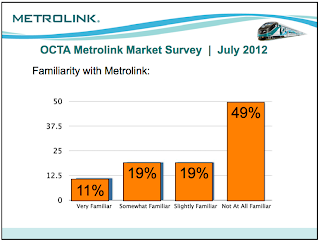2012-2013 Metrolink Budget (page 38)
For 2013, Metrolink plans on a total of 2,626,864 train miles, with an Operations & Services budget of $121,229,000 ($46.15 per mile), a Maintenance-of-Way budget of $27,686,000 (bringing it up to $56.69 per mile), Administrative & Services budget of $26,004,000 (now up to $66.59 per mile), and finally $18,600,000 in premiums per year for a final entirely allocated per mile cost of $73.86. None of these, however, are the cost of running a particular train, but are instead are the cost of running commuter services on a mixed use railroad. Note that these costs include the maintenance and dispatch costs of hosting freight and Amtrak intercity passenger traffic, but not their revenues as well as the costs of transfer payments for connections to local transit and the Rail2Rail program.
Looking strictly at costs which are best allocated on a per train mile basis, that is, the marginal cost of running a train, we have the categories of Train Operations, Equipment Maintenance, and Fuel.
Train Operations is the single largest expense category for Metrolink, coming in at $36,531,000 and accounts for the costs of the train crews and dispatchers. It's worth bearing in mind that, to my knowledge, Metrolink runs with only an engineer and conductor (and possibly a second conductor on certain trains). Amtrak's intercity trains, with multiple conductors and a lead service attendant in the café, will be higher and the long-distance sleepers, which have a dozen or more crew members, even higher yet.
Equipment Maintenance is fairly straight forward at $23,036,000. In truth, this might be better expressed in terms of vehicle-miles rather than train-miles, but I do not have that information at hand and as long as train sizes are relatively consistent (in this case, 5-6 cars are increasingly common) it shouldn't be an issue. Where it isn't a near-match, scaling for sizes may be appropriate. Age of the equipment is an additional factor as well.
Fuel is self-explanatory and costs $27,250,000. Metrolink averages 2.7 gallons per train-mile with their heavier new Rotem cars and long consists and budgets $3.75 per gallon, which represents $10.125 per mile. By way of comparison, an electric train which consumes 30 kWh per train-mile at 12¢ per kWh would have a fuel cost of only $3.60 per train-mile and many trains average less.
With the proviso about equipment maintenance kept in mind, the total marginal cost of running a Metrolink train is $33.05 per mile. This may be slightly low as I did not include Rail Agreements in the allocation on the basis of the belief that this is predominated by maintenance charges rather than dispatch services; as over half of Metrolink's dispatching expenses are balanced by dispatching revenues, I suspect it evens out.
There are a number of other costs involved with running a full rail service or railroad however, several of which may be validly allocated on a per train-mile basis, even if they don't strictly scale with it. Other Operating Train Services, for instance, includes "Weather data forecast and earthquake reporting services, publications, uniforms, emergency bus services, and FRA required training." While these costs don't really scale with the number of train-miles run, one would be hard pressed to deny that train-miles makes for an appropriate manner to apportion the costs between various supporting agencies.
Other costs may scale with train-miles, but are not a marginal cost and are at the discretion of the agency. If one sends out a uniformed officer on a certain percentage of trains, the cost will scale, but there's no requirement to do so and, for that matter, I do not believe that to be the practice of Metrolink. As it happens, the additive for police in Amtrak's contracting agreement with the various states is actually based on passenger-miles, not train-miles. Certain of the costs scale with the number of passengers rather than the trains themselves. This is true of TVM Maintenance/Revenue Collection which is dominated by ticket stock costs and merchant fees. To a lesser degree this is true of Passenger Relations as well.
Maintenance of Way is the category which is closest to being a train-mile marginal cost which I did not include. However, as Metrolink noted:
Member Agency contributions for ordinary maintenance are partially offset by revenues received from the freight railroads and Amtrak Intercity services. These revenue rates were negotiated based on the historical expenditures on maintenance of way by freight railroads prior to the purchase of these right of way properties by the Member Agencies. Consequently, these revenue rates do not completely offset the escalating costs of maintaining a higher standard of quality for passenger rail serviceIt might be better to simply hold it as reflecting the cost of owning a mixed use railroad (average cost per track-mile: $73,267) as a result. If we ignore that these costs are not entirely off-set and bundle Rail Agreements in with it, the pessimistic estimate is $6.59 per train-mile (compare to Amtrak's average payment of $4.44 per train-mile in 2009).




